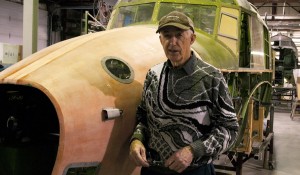By Jessica Corriveau
 [1]
[1]TRENTON, Ont. (03/31/2011) - Retired Royal Canadian Air Force Sergeant Guy Cuerrier stands in front of a 1942 training plane for war pilots being restored by a team of veteran volunteers at CFB Trenton. Cuerrier has been volunterring since the beginning of the restoration program. Photo by Jessica Corriveau
Even at 79 years old retired Royal Canadian Air Force Sergeant Guy Cuerrier still spends his days on the base where he first enlisted.
Every day since it opened in 1996, Cuerrier has returned to the Rotary Restoration Shop at the National Air Force Museum at CFB Trenton. He volunteers with a team of people who put in a combined 30,000 hours of work every year restoring and rebuilding recovered aircrafts dating back to the second World War.
Gesturing to the corroded instruments in the cockpit of a 1942 training plane, one of several aircrafts currently being restored, Cuerrier tells of a different time in Canada’s Air Force history. Cuerrier entered the RCAF at 19, and became an instrument technician in avionics, aircraft electronics.
“When I enlisted in 1951, of course all instrumentation in aircraft was very, very basic. It wasn’t too complicated. It was basic electricity, not electronics as we know them today. This was before transistors even,” said Cuerrier. “Today, it’s all computerized.”
Cuerrier was part of the team that restored the Air Force’s museum’s largest airplane, the Handley Page Halifax. One of only three remaining in the world, it was shot down in Norway in April of 1945, and 250 metres deep in Lake Mjosa about 100 kilometres north of Olso. It is the most technically accurate rebuilt Halifax.
“We have an Avro Anson (trainer aircraft), and a Lockheed Hudson (bomber plane) currently in the shop. We’ve had the Anson for three years, and the Hudson for six months,” said Guy Barsi, a volunteer in the restoration workshop. “We don’t know when they’ll be done, since it’s all on a volunteer basis and people come and go, and work at their own pace.”
Also being restored at the museum but currently in the paint shop on base is a Harvard trainer, a small, single-engine plane used to train Allied forces pilots.
“When I came here in the early 1950s, we had a lot of Harvard trainers left over from WWII, and we even ordered some new ones!
“That was the backbone of the training airplanes,” said Cuerrier. “You went from the Harvard, when you got proficient at that, right to a Spitfire or a Hercules plane.”
Retired in 1985, Cuerrier spent nearly his entire career working in the hanger, installing electronic components in the cockpits of the aircrafts at various Canadian Forces bases. He even went so far as to take a pay cut and accept a demotion to continue working on planes past the Canadian Forces’ required retirement at age 50, rather than take on the administrative duties associated with higher ranks.
Throughout his military career, Cuerrier has worked on several different kinds of planes, including Buffalo carrier planes and their successor, the Hercules transport planes, which can be seen flying over the Trenton and Belleville area on a regular basis.
Originally stationed at CFB Trenton, Cuerrier also worked on aircraft at CFB Winnipeg, and spent time in Germany, Scotland, and Egypt with the RCAF. His wife and four children even travelled to Germany and lived on base with him.
“I put so much work into the Harvard trainer, and it’s up there (getting painted), the fuselage and the wings are off, so before I quit here I’d like to see it back here with the wings on, and I can say ‘Ah, I’ve done my thing here’.”
Admission is free at the National Air Force Museum, which is open Wednesday through Saturday until April 30, and daily from May 1 to Sept. 30.